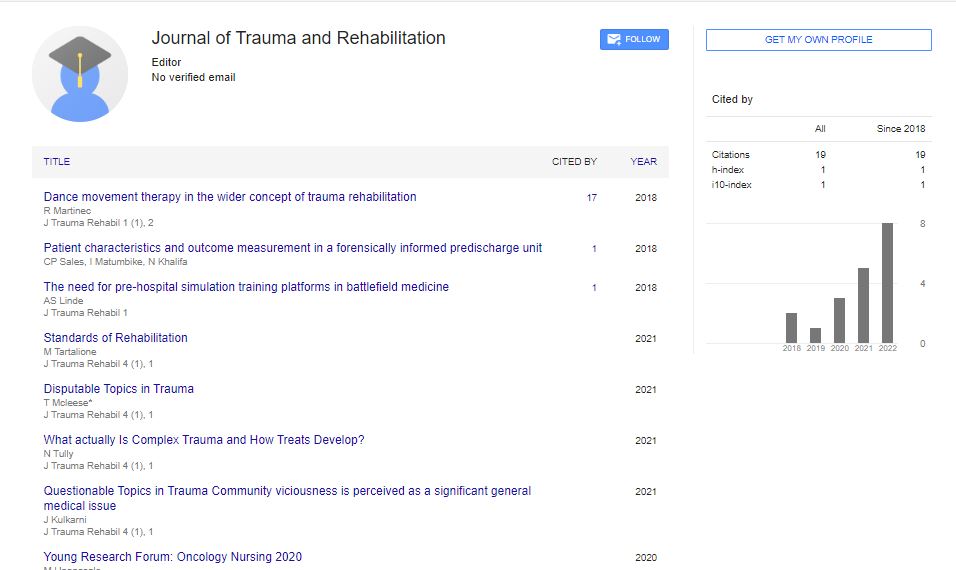Perspective, J Trauma Rehabil Vol: 6 Issue: 3
Exploring the Spinal Cord Trauma, Functions and Treatment
Federick Lean*
1Department of Orthopaedic Surgery, Northwestern University, Chicago United States of America
*Corresponding Author: Federick Lean,
Department of Orthopaedic Surgery,
Northwestern University, Chicago United States of America
E-mail: federick_lean@nu11.edu
Received date: 23 August, 2023, Manuscript No. JTR-23-118513;
Editor assigned date: 25 August, 2023, PreQC No. JTR-23-118513 (PQ);
Reviewed date: 08 September, 2023, QC No. JTR-23-118513;
Revised date: 15 September, 2023, Manuscript No. JTR-23-118513 (R);
Published date: 22 September, 2023, DOI: 10.4172/Jtr.1000135
Citation: Lean F (2023) Exploring the Spinal Cord Trauma, Functions and Treatment. J Trauma Rehabil 6:3.
Description
The spinal cord is a remarkable structure, serving as an essential link between the brain and the body. Unfortunately, spinal cord trauma, often caused by accidents, falls, or sports injuries, can have profound and life-altering consequences. The spinal cord is a long, slender, and delicate bundle of nerves protected by the vertebrae of the spine. It plays a central role in the communication between the brain and the body. The spinal cord acts as a relay station for sensory information. Nerve impulses carrying information about touch, pain, temperature, and proprioception (awareness of body position) are transmitted from the body to the brain and vice-versa.
It also coordinates motor functions. When the brain sends commands to move, the spinal cord conveys these messages to the muscles, allowing for voluntary movement. The spinal cord can generate reflex movements without input from the brain. This rapid, involuntary response can be life-saving, such as when you pull your hand away from a hot surface before your brain even registers the pain. When the spinal cord experiences trauma, the repercussions can be severe and life-changing. The extent of the damage depends on several factors, including the location and severity of the injury.
Spinal cord injuries can lead to partial or complete loss of motor function and sensation below the level of the injury. Paralysis can affect the legs (paraplegia) or both the arms and legs (quadriplegia). Damage to the spinal cord often results in sensory deficits, such as numbness, tingling, or loss of sensation in affected areas. Spinal cord trauma can disrupt autonomic functions, affecting blood pressure, heart rate, body temperature, and bladder and bowel control.
Many individuals with spinal cord injuries experience chronic pain, which can be challenging to manage and significantly impact their quality of life. Injuries to the cervical spine may impair respiratory function, requiring assisted breathing devices. Over the years, advancements in medical science and rehabilitation have transformed the landscape of spinal cord trauma treatment. While complete recovery from severe injuries remains a challenge, the focus has shifted towards enhancing the quality of life and functional abilities of those affected. In the immediate aftermath of a spinal cord injury, prompt medical attention is vital to stabilize the patient and prevent further damage. Surgery may be necessary to remove bone fragments, foreign objects, or to realign the spine. In some cases, surgery can help decompress the spinal cord.
Physical therapists play a vital role in helping individuals regain strength and mobility. Adaptive equipment, such as wheelchairs, braces, and orthotics, may be prescribed to improve independence. Occupational therapists help patients develop skills and strategies to perform daily activities, promoting independence and quality of life. Advances in assistive technologies, including exoskeletons and functional electrical stimulation devices, provide new possibilities for individuals with spinal cord injuries. Medications can be prescribed to manage pain, spasticity, and other complications associated with spinal cord trauma.
Managing with the psychological and emotional impact of spinal cord trauma is essential. Mental health professionals provide important support for both patients and their families. Studies into regenerative therapies, such as stem cell treatments and nerve regeneration techniques, provide hope for potential future recovery options.
Conclusion
Spinal cord trauma is a life-altering event that affects not only the individual but also their family and community. Understanding the functions of the spinal cord and the effects of trauma is important in guiding treatment and rehabilitation efforts. While complete recovery remains a challenge, advancements in medical science and rehabilitative therapies provide belief and an improved quality of life for those affected by spinal cord injuries. As continues to expand the knowledge of spinal cord trauma and regenerative possibilities, the future holds hope for more effective treatments and potential cures.
 Spanish
Spanish  Chinese
Chinese  Russian
Russian  German
German  French
French  Japanese
Japanese  Portuguese
Portuguese  Hindi
Hindi 